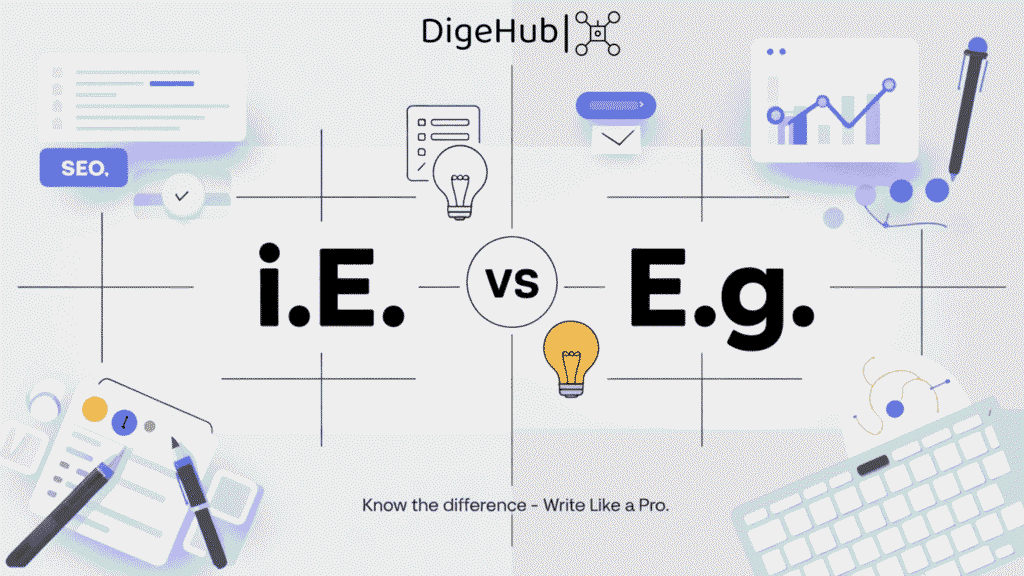i.e. vs e.g.: What is the Difference and How to Use Them in Content, SEO & Marketing Copy Correctly

Have you ever found yourself staring at a sentence, wondering whether to use “i.e.” or “e.g.”? You’re not alone. while writing this blog i too. These two Latin abbreviations cause confusion for writers, marketers, and content creators worldwide. While they might seem interchangeable, using them incorrectly can undermine your credibility and confuse your readers.
In this comprehensive guide, we’ll explore everything you need to know about i.e. vs e.g., including their definitions, differences, proper usage, and how to leverage them effectively in your SEO and marketing copy.
- What Do i.e. and e.g. Mean? Understanding the Basics
- The Key Difference Between i.e. and e.g.
- When to Use i.e. vs e.g.: Practical Guidelines
- How to Use i.e. and e.g. in Sentences: Grammar and Punctuation
- Common Mistakes: i.e. vs e.g. Usage Errors to Avoid
- i.e. vs e.g. in Different Writing Styles
- SEO Benefits: How to Use i.e. and e.g. for Better Rankings
- Answer Engine Optimization (AEO): Structuring Content for AI
- Alternatives to i.e. and e.g.: When to Use Other Phrases
- Industry-Specific Usage: i.e. vs e.g. in Different Fields
- Advanced Tips: Mastering i.e. and e.g. in Professional Writing
- Quick Reference Guide: i.e. vs e.g. Cheat Sheet
- Testing Your Knowledge: i.e. vs e.g. Quiz
- The Impact on Content Quality and User Experience
- Common Questions About i.e. vs e.g.
- Best Practices for Content Creators and Marketers
- Conclusion: Mastering i.e. vs e.g. for Better Communication
What Do i.e. and e.g. Mean? Understanding the Basics
Before diving into the differences, let’s establish what these abbreviations actually stand for and mean.
What Does i.e. Mean?
i.e. is an abbreviation for the Latin phrase “id est,” which translates to “that is” or “in other words” in English. When you use i.e., you’re providing a complete explanation or clarification of what you just mentioned. It introduces a comprehensive list or definition that encompasses everything you’re referring to.
Think of i.e. as saying “specifically” or “namely” – you’re being precise and exhaustive in your explanation.
What Does e.g. Mean?
e.g. stands for “exempli gratia,” a Latin phrase meaning “for example” or “for the sake of example.” When you use e.g., you’re providing one or more examples from a larger group, but you’re not listing everything. It’s an incomplete list that illustrates your point without being exhaustive.
Consider e.g. as shorthand for “such as” or “including” – you’re giving representative examples, not a complete inventory.
The Key Difference Between i.e. and e.g.
The fundamental difference between ie and eg lies in completeness:
- i.e. = Complete list or total clarification
- e.g. = Partial list or examples
Here’s a simple way to remember: i.e. means “in essence” (everything), while e.g. means “example given” (some things).
Visual Comparison: i.e. vs e.g.
| Aspect | i.e. (id est) | e.g. (exempli gratia) |
|---|---|---|
| Meaning | That is, in other words | For example, such as |
| Usage | Complete explanation | Partial examples |
| List type | Exhaustive | Selective |
| Purpose | Clarification | Illustration |
| Completeness | 100% of items | Some representative items |
When to Use i.e. vs e.g.: Practical Guidelines
When to Use i.e.
Use i.e. when you want to:
- Provide a complete definition or explanation
- Clarify exactly what you mean
- List all items in a category
- Rephrase something for clarity
Example: “The primary colors (i.e., red, blue, and yellow) cannot be created by mixing other colors.”
In this case, there are only three primary colors, so the list is complete and exhaustive.
When to Use e.g.
Use e.g. when you want to:
- Give examples from a larger group
- Illustrate your point without being exhaustive
- Provide representative samples
- Keep your writing concise
Example: “Social media platforms (e.g., Facebook, Instagram, Twitter) have transformed how we communicate.”
Here, there are many more social media platforms than the three mentioned, making this a partial list of examples.
How to Use i.e. and e.g. in Sentences: Grammar and Punctuation
How to Use ‘i.e.’ Correctly
i.e. stands for the Latin phrase id est, which translates to “that is” in English. This powerful little abbreviation serves to introduce a word or phrase that restates, clarifies, or provides a complete explanation of what you’ve just mentioned. Think of it as your way of saying “in other words” or “specifically.”
When you use i.e., you’re essentially rephrasing something to make it clearer for your readers. Here’s how it works in practice:
Example 1: Clarifying Geographic Terms “Several battleground states from the industrial heartland, i.e., Pennsylvania, Michigan, and Wisconsin, played crucial roles in the election outcome due to their economic transformation over recent decades.”
Example 2: Defining Technical Terms
“Choose a butterflied fish—i.e., one that has been deboned and opened flat—season it with citrus and spices, then bake for approximately 10 minutes for optimal results.”
Example 3: Explaining Home Maintenance Concepts “If your home has hard water (i.e., water with high mineral content), you’ll likely notice white or yellowish buildup on your sinks, showers, and bathtubs over time.”
How to Use ‘e.g.’ Effectively
e.g. comes from the Latin exempli gratia, meaning “for example” or “for the sake of example.” This abbreviation introduces specific examples from a larger category, helping illustrate your point without providing an exhaustive list.
Unlike i.e., when you use e.g., you’re not trying to be complete—you’re simply offering representative samples that demonstrate your broader point.
Example 1: Setting Timelines “Establish a specific timeframe, e.g., three weeks or one month, to master these new skills and see measurable progress.”
Example 2: Illustrating Brand Messaging “Some companies use unconventional marketing approaches, e.g., printing philosophical messages on product packaging, quirky social media campaigns, or unexpected brand collaborations that grab attention.”
Punctuation Rules for Both i.e. and e.g.
Both abbreviations follow consistent punctuation patterns that ensure clarity and readability:
Essential Punctuation Guidelines:
- Always include periods after each letter (i.e., not ie)
- Typically use a comma before the abbreviation when it follows the main clause
- Always use a comma after the abbreviation before continuing
- Consider parentheses or em dashes for better visual separation
Standard Formats:
- “Text, i.e., complete explanation”
- “Text (i.e., complete explanation)”
- “Text—i.e., complete explanation—continues”
Real-World Punctuation Examples
Professional i.e. Usage:
- “Our core service offerings, i.e., SEO optimization, content marketing, social media management, and paid advertising, form a comprehensive digital strategy.”
- “The primary colors (i.e., red, blue, and yellow) cannot be created by mixing other pigments.”
Effective e.g. Usage:
- “Popular content management systems, e.g., WordPress, Drupal, and Joomla, offer different advantages for website development.”
- “Social media platforms (e.g., Instagram, TikTok, LinkedIn) each require tailored content strategies.”
Pro Tip for Clarity: If you’re ever unsure whether you’ve chosen correctly, try substituting the English equivalents: replace i.e. with “that is” or e.g. with “for example.” If your sentence still makes perfect sense, you’ve made the right choice.
Common Mistakes: i.e. vs e.g. Usage Errors to Avoid
Mistake #1: Using i.e. for Partial Lists
Incorrect: “Popular beverages, i.e., coffee, tea, juice, are available.” Correct: “Popular beverages, e.g., coffee, tea, juice, are available.”
Why? There are many more beverages than those listed, so e.g. is appropriate.
Mistake #2: Using e.g. for Complete Lists
Incorrect: “Traffic light colors, e.g., red, yellow, green, control intersections.” Correct: “Traffic light colors, i.e., red, yellow, green, control intersections.”
Why? Standard traffic lights only have these three colors, making it a complete list.
Mistake #3: Punctuation Errors
Incorrect: “Content types ie blog posts and videos” Correct: “Content types, i.e., blog posts and videos” (if these are the only two types you’re discussing)
Mistake #4: Overusing Latin Abbreviations
Problem: “Marketing strategies, e.g., SEO, i.e., search optimization, and PPC, e.g., Google Ads, drive traffic.” Better: “Marketing strategies such as SEO (search engine optimization) and PPC advertising drive traffic.”
i.e. vs e.g. in Different Writing Styles
Academic Writing: Define i.e. and e.g.
In academic contexts, precision matters:
- i.e. for exact definitions and complete categorizations
- e.g. for illustrative examples supporting broader arguments
Academic example: “Renewable energy sources (i.e., solar, wind, hydroelectric, geothermal, biomass) offer sustainable alternatives to fossil fuels. Some countries (e.g., Denmark, Costa Rica, Iceland) have made significant progress in renewable adoption.”
Business and Marketing Copy
In marketing materials, clarity and engagement are key:
- i.e. for precise product specifications or complete service offerings
- e.g. for showcasing diverse applications or client examples
Marketing example: “Our comprehensive digital marketing suite includes all essential tools (i.e., SEO optimization, social media management, email automation, and analytics tracking). We’ve helped businesses across various industries (e.g., healthcare, e-commerce, SaaS, real estate) achieve their growth goals.”
Casual and Blog Writing
For conversational content, use these abbreviations sparingly:
Casual example: “There are tons of productivity apps out there (e.g., Todoist, Asana, Trello) that can help organize your workflow.”
SEO Benefits: How to Use i.e. and e.g. for Better Rankings
Keyword Integration Strategy
Using i.e. and e.g. can help with SEO in several ways:
- Semantic richness: These abbreviations help search engines understand relationships between concepts
- Long-tail keyword opportunities: Natural placement of related terms
- Content depth signals: Demonstrating comprehensive topic coverage
SEO Example in Action
Instead of: “Digital marketing includes SEO and social media.”
Try: “Digital marketing encompasses various strategies (i.e., search engine optimization, social media marketing, content marketing, email campaigns, and paid advertising). Popular platforms (e.g., Google, Facebook, LinkedIn, Instagram) offer different opportunities for business growth.”
This approach naturally incorporates related keywords while providing valuable context.
Answer Engine Optimization (AEO): Structuring Content for AI
With the rise of AI-powered search, proper use of i.e. and e.g. helps:
- Clarify relationships between concepts for AI understanding
- Provide context that improves content interpretation
- Structure information in digestible, logical formats
AEO-Optimized Example
“What is content marketing? Content marketing involves creating valuable material (i.e., blog posts, videos, infographics, podcasts, and social media content) to attract and engage target audiences. Successful brands (e.g., HubSpot, Buffer, Mailchimp) use content marketing to build trust and drive conversions.”
Alternatives to i.e. and e.g.: When to Use Other Phrases
Instead of i.e., Use:
- “That is”
- “In other words”
- “Specifically”
- “Namely”
- “Which means”
Instead of e.g., Use:
- “For example”
- “Such as”
- “Including”
- “Like”
- “Among others”
Why Consider Alternatives?
- Readability: Not all readers understand Latin abbreviations
- Accessibility: Clearer for non-native English speakers
- SEO diversity: Varies your language naturally
- Tone matching: Better fits conversational content
Industry-Specific Usage: i.e. vs e.g. in Different Fields
Legal Writing
Legal documents require precision:
- i.e. for exact legal definitions
- e.g. for case examples or non-exhaustive lists
Legal example: “Intellectual property rights (i.e., patents, trademarks, copyrights, and trade secrets) protect business innovations. Various industries (e.g., technology, pharmaceuticals, entertainment) rely heavily on IP protection.”
Technical Documentation
Technical writing demands clarity:
- i.e. for complete system components
- e.g. for example implementations or use cases
Technical example: “The authentication system requires specific credentials (i.e., username, password, and two-factor authentication code). Compatible devices (e.g., smartphones, hardware tokens, biometric scanners) can provide the second factor.”
Medical and Scientific Writing
Healthcare content needs accuracy:
- i.e. for complete symptom lists or exact classifications
- e.g. for example conditions or representative studies
Medical example: “Cardiovascular disease risk factors include lifestyle elements (i.e., diet, exercise, smoking, alcohol consumption, and stress management). Certain conditions (e.g., diabetes, hypertension, obesity) significantly increase risk levels.”
Advanced Tips: Mastering i.e. and e.g. in Professional Writing
Tip 1: Match Your Audience’s Familiarity
For general audiences: Use plain English alternatives For professional audiences: Latin abbreviations are typically acceptable For international audiences: Consider translation or explanation
Tip 2: Maintain Parallel Structure
Correct: “Marketing channels (e.g., email, social media, content marketing) require different strategies.” Incorrect: “Marketing channels (e.g., email, using social media, and when you create content) require different strategies.”
Tip 3: Avoid Redundancy
Redundant: “For example, e.g., social media platforms like Facebook” Better: “Social media platforms (e.g., Facebook, Instagram, Twitter)”
Tip 4: Consider Context and Flow
Choppy: “We offer services, i.e., SEO, PPC, social media. These help businesses, e.g., retailers, SaaS companies, grow online.”
Smooth: “We offer comprehensive digital marketing services, specifically SEO, PPC, and social media management. These solutions help various businesses, such as retailers and SaaS companies, grow their online presence.”
Quick Reference Guide: i.e. vs e.g. Cheat Sheet
Memory Devices
- i.e. = “In Essence” (everything included)
- e.g. = “Example Given” (some examples)
Decision Tree
- Am I providing ALL possible items? → Use i.e.
- Am I giving some examples from a larger group? → Use e.g.
- Am I clarifying or restating something? → Use i.e.
- Am I illustrating with samples? → Use e.g.
Quick Examples for Reference
Complete lists (i.e.):
- “Primary colors (i.e., red, blue, yellow)”
- “Days of the weekend (i.e., Saturday and Sunday)”
- “Fundamental forces (i.e., gravity, electromagnetic, strong nuclear, weak nuclear)”
Partial examples (e.g.):
- “Social media platforms (e.g., Facebook, Twitter, Instagram)”
- “Programming languages (e.g., Python, JavaScript, Java)”
- “European capitals (e.g., Paris, London, Berlin)”
Testing Your Knowledge: i.e. vs e.g. Quiz
Try identifying whether these sentences use i.e. or e.g. correctly:
- “Citrus fruits, i.e., oranges, lemons, limes, are rich in vitamin C.”
- “The company’s founders, i.e., John and Sarah, started the business in 2010.”
- “Popular video platforms, e.g., YouTube, TikTok, Vimeo, offer monetization options.”
- “Primary web browsers, e.g., Chrome, Firefox, Safari, Edge, support modern standards.”
Answers:
- Incorrect – Should be e.g. (there are more citrus fruits)
- Correct – i.e. is appropriate (complete list of founders)
- Correct – e.g. is appropriate (examples from many platforms)
- Incorrect – Should be i.e. if these are the only primary browsers being discussed, or e.g. if representing a larger group
The Impact on Content Quality and User Experience
Why Proper Usage Matters
- Credibility: Correct usage demonstrates attention to detail
- Clarity: Readers understand your intent more clearly
- Professionalism: Proper grammar enhances your authority
- SEO benefits: Search engines better understand content relationships
User Experience Considerations
Clear communication leads to:
- Reduced bounce rates
- Increased time on page
- Better user engagement
- Higher conversion rates
Common Questions About i.e. vs e.g.
Is it “eg” or “e.g.”?
Always use periods: e.g. (not “eg”) Similarly: i.e. (not “ie”)
Can you use i.e. and e.g. in the same sentence?
While grammatically possible, it’s usually better to restructure for clarity:
Awkward: “Digital tools, e.g., software programs, i.e., applications and platforms, help businesses.” Better: “Digital tools such as software applications and platforms help businesses streamline operations.”
Should you italicize i.e. and e.g.?
Generally, no. These abbreviations are so commonly used that italicization isn’t necessary. However, follow your style guide’s specific requirements.
Are there pronunciation differences?
- i.e. is typically pronounced “that is” or spelled out as “i-e”
- e.g. is usually pronounced “for example” or spelled out as “e-g”
Best Practices for Content Creators and Marketers
Content Strategy Integration
- Use sparingly: Don’t overload content with Latin abbreviations
- Consider your audience: Match formality to reader expectations
- Maintain consistency: Choose a style and stick to it throughout your content
- Provide value: Ensure each usage adds clarity, not confusion
SEO and Marketing Applications
Blog posts: Use for natural keyword integration and semantic richness Product descriptions: Clarify features (i.e.) and show applications (e.g.) Email marketing: Enhance clarity in promotional content Social media: Keep casual, consider alternatives for broader appeal
Visit our blog section for more writing and SEO tips to enhance your content strategy.
Conclusion: Mastering i.e. vs e.g. for Better Communication
Understanding the difference between i.e. and e.g. is more than just grammar knowledge—it’s about clear, effective communication. When you use these abbreviations correctly, you demonstrate professionalism, enhance readability, and improve your content’s SEO potential.
Remember the key distinction: i.e. means “that is” (complete), while e.g. means “for example” (partial). Whether you’re writing blog posts, creating marketing copy, or developing technical documentation, this knowledge will serve you well.
The next time you’re writing content, pause and ask yourself: “Am I providing everything (i.e.) or just some examples (e.g.)?” This simple question will guide you to the correct choice every time.
For more insights on effective writing and digital marketing strategies, explore the resources available at Digehub.com. Master these fundamentals, and watch your content’s clarity and impact improve significantly.
Quick Takeaway: Use i.e. for complete lists and exact clarifications, use e.g. for examples and illustrations. When in doubt, spell it out with “that is” or “for example” to ensure your message is crystal clear.



